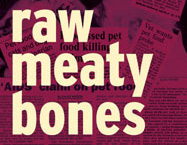
 | FOR PET OWNERS |
 | ARTICLES |
 | RMB NEWSLETTER ARCHIVE |
 | MEDIA ARCHIVE |
 | MISCELLANEOUS |
 | ABOUT THIS WEBSITE |

Visit our photo gallery
Bligh Park Pet Health Centre
Dr Mei Yam & Associates
Raw Meaty Bones for Dogs, Cats and FerretsSo it is when providing fuel (food) for our carnivorous pets. Dogs, cats and ferrets function best when we feed them as nature intended. Definitely, without doubt, the best food for pets is that eaten by their wild cousins: the wolves, desert cats and polecats. In the wild it’s a case of survival of the healthiest. There are no veterinary hospitals or animal dentists in the wilderness. In remote places a natural diet provides the ideal ‘fuel’. It cleans the carnivores’ teeth and keeps the animals in peak fitness and health. We can say that a raw, natural diet acts as food and medicine combined. At their dining table of bare earth, wild carnivores crouch over a kill, ripping and tearing at the hide, guts, meat and bones. When all that remains are a few feathers or fragments of bone, the carnivore, belly distended, licks his lips in satisfaction and sets off to the stream for a drink. Next comes a long siesta allowing the digestive juices to go to work extracting the vital nutrients for energy, growth and body repair — and thus enable our wild carnivore to thrive and hunt another day. It’s all part of nature’s exquisite balance, perfected over millions of years of evolution. However, as a pet owner, you don’t have millions of years and want to know the best diet available today! First, I encourage you to engage with your inner thoughts and calm your fears. Whilst your dog/cat/ferret may look like a cute bundle of fur, on the inside it still retains the physiological and nutritional needs of its wild ancestors. As the ‘pack leader’ you have the privilege and the responsibility to deliver the best food possible. Granted, finding a reliable source of supply may be difficult, but even feeding a whole carcass as a treat once a week is better than not at all. You may know hunters, fishermen and farmers who have access to whole deer, rabbits, chickens and fish. These days there are online suppliers, fish shops and specialty outlets that can supply the ideal diet. Reptile keepers have always fed mice, rats and rabbits to their captive snakes and lizards. Those who keep birds of prey know where to buy day-old chicks. Your local zoo or university research labs may be able to help and the internet discussion forums are a good source of information. If, however, the thought of feeding whole carcasses complete with fur, feathers, fins and entrails leaves you feeling mortified, then breathe easy. The second best and practical option — raw meaty bones and a few table scraps — is easy, economical and efficient and will have your pet living a long and healthy life. There’s a three page Diet Guide at: https://www.rawmeatybones.com/diet/exp-diet-guide.pdf Take time to study and digest the information. Nature is adaptable, but the one critical aspect is that the bulk of the diet needs to be raw meaty bones in large lumps. Best to start with meaty bones from one source, for instance chicken or turkey. Soon your pets will be glowing with health just like the pets in the Readers Photos.  What is the Raw Meaty Bones diet for dogs, cats & ferrets? (PDF version) What is the Raw Meaty Bones diet for dogs, cats & ferrets? (PDF version)
|
| Raw Meaty Bones |